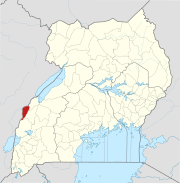Bundibugyo | |
|---|---|
 | |
| Coordinates: 00°42′45″N 30°03′36″E / 0.71250°N 30.06000°E | |
| Country | |
| Region | Western Uganda |
| Sub-region | Rwenzururu sub-region |
| District | Bundibugyo District |
| Elevation | 3,461 ft (1,055 m) |
| Population (2020 Estimate) | |
• Total | 22,300[1] |
| Climate | Am |
Bundibugyo is a town in the Western Region of Uganda. It is the 'chief town' of Bundibugyo District and the district headquarters are located there.[2]
Location
Bundibugyo is located approximately 85 kilometres (53 mi), by road, west of Fort Portal, the nearest large city. The direct distance is much shorter, due to the steep terrain and winding nature of the roads in the neighborhood.[3] The town of Bundibugyo is located approximately 378 kilometres (235 mi), by road, west of Kampala, the largest city and national capital of Uganda.[4]
The geographical coordinates of Bundibugyo town are:0°42'45.0"N 30°03'36.0"E (Latitude:0.712500; Longitude: 30.059999).[5] Bundibugyo Town Council sits at an average elevation of 3,461 feet (1,055 m) above mean sea level, lying between 2,477 feet (755 m) and 7,733 feet (2,357 m) above sea level.[6]
Overview
Bundibugyo is one of the most western of all Uganda's district capitals. Although Kisoro, Kanungu and Rukungiri are located further west than Bundibugyo, it is the only Ugandan district capital located west of the Rwenzori Mountains. It sits at an altitude of approximately 900 metres (3,000 ft), above sea level. The predominant ethnicities in the town are the Bamba and the Bakonjo. However other ethnicities coexist with them including the Batooro, Bakiga, Banyoro and the Banyankole.[7]
Population
The 2002 national census enumerated the population of Bundibugyo at 13,782. In 2010, the Uganda Bureau of Statistics (UBOS), estimated the population of the town at 20,500. In 2011, UBOS estimated the mid-year population of Bundibugyo at 21,600.[8]
In 2014, the national population census put the town's population at 18,823. In 2015 UBOS estimated the town's population at 19,000. In 2020, the population agency estimated the mid-year population of Bundibugyo Town Council at 22,300. Of those, 11,400 (51.1 percent) were females and 10,900 (48.9 percent) were males. UBOS calculated that the population of the town increased at an average rate of 3.3 percent annually between 2015 and 2020.[1]
| Year | Pop. | ±% |
|---|---|---|
| 2002 | 13,782 | — |
| 2010 | 20,500 | +48.7% |
| 2011 | 21,600 | +5.4% |
| 2014 | 18,823 | −12.9% |
| 2015 | 19,000 | +0.9% |
| 2020 | 22,300 | +17.4% |
| source:[1][8] | ||
Points of interest
The following points of interest lie within the town or close to its borders:[5]
1. The headquarters of Bundibugyo District Administration
2. The offices of Bundibugyo Town Council
3. Bundibugyo Central Market, the largest source of fresh produce in the town
4. Bundibugyo General Hospital, a 160-bed public hospital administered by the Uganda Ministry of Health
5. A branch of Stanbic Bank
6. Bundibugyo Airport, a civilian airport
7. Ebenezer Seventh-day Adventist Church, a place of worship affiliated with the Seventh Day Adventist faith.
See also
References
- ^ a b c Uganda Bureau of Statistics (14 June 2020). "The population development of Bundibugyo as well as related information and services" (Citypopulation.de Quoting Uganda Bureau of Statistics). Citypopulation.de. Retrieved 20 July 2021.
- ^ Uganda Radio Network (24 November 2020). "NUP Denied Campaign Venue In Bundibugyo Town Council" (The Independent (Uganda) Quoting Uganda Radio Network). The Independent (Uganda). Kampala, Uganda. Retrieved 20 July 2021.
- ^ "Road Distance Between Bundibugyo, Uganda And Fort Portal, Uganda" (Map). Google Maps. Retrieved 20 July 2021.
- ^ "Road Distance Between Bundibugyo, Uganda And Kampala, Uganda" (Map). Google Maps. Retrieved 20 July 2021.
- ^ a b "Location of Bundibugyo Municipal Council, Bundibugyo District, Western Region, Uganda" (Map). Google Maps. Retrieved 20 July 2021.
- ^ Topographic Map (20 July 2021). "Elevation of Bundibugyo Town Council, Uganda". Topographic-map.com. Retrieved 20 July 2021.
- ^ Data Africa (2014). "Data Profile of Bundibugyo". Data Africa. Retrieved 20 July 2021.
- ^ a b Uganda Bureau of Statistics (2012). "Estimated Population of Bundibugyo In 2002, 2010 And 2011" (PDF). Uganda Bureau of Statistics. Kampala, Uganda. Archived from the original (Archived from the original on 7 July 2014) on 7 July 2014. Retrieved 20 July 2021.
External links










